- Financial Performance – A Complete Tutorial
- How Six Sigma Principles Can Progress Your Productivity – Tutorial
- Google Analytics Pro Tutorial | Fast Track your Career
- Activity-Based Costing Tutorial | Know about Definition, Process, & Example
- Create a workbook in Excel Tutorial | Learn in 1 Day
- Excel ROUNDUP Formula Tutorial | Learn with Functions & Examples
- Business Analytics with Excel Tutorial | Learn In 1 Day
- SAP Tutorial – Free Guide Tutorial & REAL-TIME Examples
- IBM SPSS Statistics Tutorial: Getting Started with SPSS
- SAP Security Tutorial | Basics & Definition for Beginners
- SAP Simple Finance Tutorial | Ultimate Guide to Learn [Updated]
- SAP FIORI Tutorial | Learn in 1 Day FREE
- Introduction to Business Analytics with R Tutorial | Ultimate Guide to Learn
- Tableau Desktop Tutorial | Step by Step resource guide to learn Tableau
- Implementing SAP BW on SAP HANA | A Complete Guide
- SAP HANA Administration | Free Guide Tutorial & REAL-TIME Examples
- Tableau API Tutorial | Get Started with Tools, REST Basics
- SAP FICO ( Financial Accounting and Controlling ) Tutorial | Complete Guide
- Alteryx Tutorial | Step by Step Guide for Beginners
- Getting started with Amazon Athena Tutorial – Serverless Interactive | The Ultimate Guide
- Introduction to Looker Tutorial – A Complete Guide for Beginners
- Sitecore Tutorials | For Beginners Learn in 1 Day FREE |Ultimate Guide to Learn [UPDATED]
- Adobe Analytics Tutorial – The Ultimate Student Guide
- Splunk For Beginners – Learn Everything About Splunk with Free Online Tutorial
- An Overview of SAP HANA Tutorial: Learn in 1 Day FREE
- Statistical Package for the Social Sciences – SPSS Tutorial: The Ultimate Guide
- Splunk For Beginners – Learn Everything About Splunk with Free Online Tutorial
- Pentaho Tutorial – Best Resources To Learn in 1 Day | CHECK OUT
- Statistical Package for the Social Sciences – SPSS Tutorial: The Ultimate Guide
- An Overview of SAP HANA Tutorial: Learn in 1 Day FREE
- Spotfire Tutorial for Beginners | Quickstart – MUST- READ
- JasperReports Tutorial: Ultimate Guide to Learn [BEST & NEW]
- Charts and Tables – Qlikview Tutorial – Complete Guide
- TIBCO Business Works | Tutorial for Beginners – Learn From Home
- Cognos TM1 Tutorial : Learn Cognos from Experts
- Kibana
- Power BI Desktop Tutorial
- Tableau Tutorial
- SSAS Tutorial
- Creating Tableau Dashboards
- MDX Tutorial
- Tableau Cheat Sheet
- Analytics Tutorial
- Lean Maturity Matrix Tutorial
- MS Excel Tutorial
- Business Analysis Certification Levels & Their Requirements Tutorial
- Solution Assessment and Validation Tutorial
- Lean Six Sigma Tutorial
- Enterprise Analysis Tutorial
- Create Charts and Objects in Excel 2013 Tutorial
- Msbi Tutorial
- MicroStrategy Tutorial
- Advanced SAS Tutorial
- OBIEE Tutorial
- Tableau Server Tutorial
- OBIA Tutorial
- Business Analyst Tutorial
- Cognos Tutorial
- Qlik Sense Tutorial
- SAP-Bussiness Objects Tutorial
- SAS Tutorial
- PowerApps Tutorial
- Financial Performance – A Complete Tutorial
- How Six Sigma Principles Can Progress Your Productivity – Tutorial
- Google Analytics Pro Tutorial | Fast Track your Career
- Activity-Based Costing Tutorial | Know about Definition, Process, & Example
- Create a workbook in Excel Tutorial | Learn in 1 Day
- Excel ROUNDUP Formula Tutorial | Learn with Functions & Examples
- Business Analytics with Excel Tutorial | Learn In 1 Day
- SAP Tutorial – Free Guide Tutorial & REAL-TIME Examples
- IBM SPSS Statistics Tutorial: Getting Started with SPSS
- SAP Security Tutorial | Basics & Definition for Beginners
- SAP Simple Finance Tutorial | Ultimate Guide to Learn [Updated]
- SAP FIORI Tutorial | Learn in 1 Day FREE
- Introduction to Business Analytics with R Tutorial | Ultimate Guide to Learn
- Tableau Desktop Tutorial | Step by Step resource guide to learn Tableau
- Implementing SAP BW on SAP HANA | A Complete Guide
- SAP HANA Administration | Free Guide Tutorial & REAL-TIME Examples
- Tableau API Tutorial | Get Started with Tools, REST Basics
- SAP FICO ( Financial Accounting and Controlling ) Tutorial | Complete Guide
- Alteryx Tutorial | Step by Step Guide for Beginners
- Getting started with Amazon Athena Tutorial – Serverless Interactive | The Ultimate Guide
- Introduction to Looker Tutorial – A Complete Guide for Beginners
- Sitecore Tutorials | For Beginners Learn in 1 Day FREE |Ultimate Guide to Learn [UPDATED]
- Adobe Analytics Tutorial – The Ultimate Student Guide
- Splunk For Beginners – Learn Everything About Splunk with Free Online Tutorial
- An Overview of SAP HANA Tutorial: Learn in 1 Day FREE
- Statistical Package for the Social Sciences – SPSS Tutorial: The Ultimate Guide
- Splunk For Beginners – Learn Everything About Splunk with Free Online Tutorial
- Pentaho Tutorial – Best Resources To Learn in 1 Day | CHECK OUT
- Statistical Package for the Social Sciences – SPSS Tutorial: The Ultimate Guide
- An Overview of SAP HANA Tutorial: Learn in 1 Day FREE
- Spotfire Tutorial for Beginners | Quickstart – MUST- READ
- JasperReports Tutorial: Ultimate Guide to Learn [BEST & NEW]
- Charts and Tables – Qlikview Tutorial – Complete Guide
- TIBCO Business Works | Tutorial for Beginners – Learn From Home
- Cognos TM1 Tutorial : Learn Cognos from Experts
- Kibana
- Power BI Desktop Tutorial
- Tableau Tutorial
- SSAS Tutorial
- Creating Tableau Dashboards
- MDX Tutorial
- Tableau Cheat Sheet
- Analytics Tutorial
- Lean Maturity Matrix Tutorial
- MS Excel Tutorial
- Business Analysis Certification Levels & Their Requirements Tutorial
- Solution Assessment and Validation Tutorial
- Lean Six Sigma Tutorial
- Enterprise Analysis Tutorial
- Create Charts and Objects in Excel 2013 Tutorial
- Msbi Tutorial
- MicroStrategy Tutorial
- Advanced SAS Tutorial
- OBIEE Tutorial
- Tableau Server Tutorial
- OBIA Tutorial
- Business Analyst Tutorial
- Cognos Tutorial
- Qlik Sense Tutorial
- SAP-Bussiness Objects Tutorial
- SAS Tutorial
- PowerApps Tutorial

Tableau Server Tutorial
Last updated on 28th Sep 2020, Blog, Business Analytics, Tutorials
Tableau Server is one of the famous and centralized storage where you can bring all your related documents at a single central point which will safeguard your data and provide you the best outcome.
Tableau Server
An online platform to host and hold all the tableau workbooks, data sources and related tableau data is called Tableau Server. Tableau developed the server so that all the functionalities of Tableau could be used in the server and it helps to hold the data with the available memory. The workbooks need not be always opened and downloaded with the desktop if tableau functions are used. Access and authorizations could be given so that the files can be kept secure and protect them from hackers. The server can help the employees to collaborate on the work of the project and hence it saves time.
Let’s see some interesting points about Tableau
1.Suits Variety of Organization
Be it an individual user, mid-range organization or a giant organization, Tableau suits every kind.If its individual user. Tableau desktop is the option for you. Tableau desktop resides on your system, to create a variety of visuals that can be saved in the form of worksheets. If you want to share this kind of visuals with your peers, you can share your saved worksheet, which your peers can view if they either have a Tableau reader/ Tableau desktop available.
2.Attractive Dashboards
There are a variety of options available for building charts. These charts can help in understating data, creating attractive dashboards, doing simple statistical analytics, forecasting etc. All the development done in Tableau has been done by keeping ease of use in mind. These all properties help Business professionals bring insights to the table in an efficient way. And that is all the things which set Tableau as a tool stand so unique.
3.Handles Many Data sources
Tableau can be connected to more than 40 data sources, plus it can handle excel and csv as well. On top of that OLAP, SQL Server, DB2 etc. make Tableau win users. Tableau comes with many inbuilt data connectors which come free.
4.Connection with Programming Languages
Tableau gets connected with R and Python.
5.Tableau Community
You can easily find help from Tableau Community and Tableau Bloggers.
Subscribe For Free Demo
Error: Contact form not found.
What is the Use of Tableau Server?
Let us find out why Tableau Server came into the picture when we have already Tableau Desktop. Tableau Desktop is along with us because of the following reasons:
- If you have a huge attachment to documents.
- Where is the data source?
- Where are the SharePoint files?
- Have you forwarded the sensitive workbook data to someone now it will go to create some problem?
- If you want this on a mobile device.
- Why is this so slow?
- Which version are we using?
- Which email was that attached to?
When do we need to bring Tableau Server?
- When you have high growth, an uncontrolled environment and you want more security, collaboration, governance, and performance.
- If you want to rule in the number of data sources being used along with the rapid increase of dashboards and workbooks, each with their own metadata layers, extracts, and copies.
Tableau Server Types
Tableau comes in three kinds:
- Tableau Desktop
- Tableau Server
- Tableau Online
Tableau desktop
Tableau desktop is a standard tool, which helps you to prepare, create, explore and visualize a data set. It empowers you, encourages you to explore data in many ways. Interactive worksheets and dashboards help you uncover the hidden insights from the data through visual patterns.
Tableau Server
It comes into the picture when the dashboards created on Tableau Desktop needs to get published. It enables you to publish your dashboards to the right set of stakeholders, hence making the collaboration and sharing of dashboards simple. It helps users to publish and share their data sources as an extractor live connection. Here users need not install Tableau on their machine, and they can still interact with dashboards available on a server.
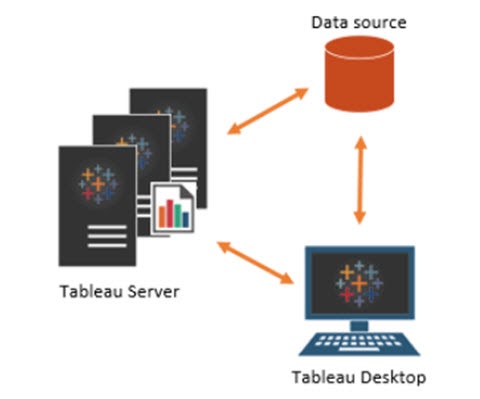
It can connect around 100 data sources which include Marketo, SAP HANA, Salesforce.com, Google BigQuery, Oracle etc.From a deployment perspective,it can be deployed on-premises as well as in public cloud like Azure, AWS, IBM Cloud, Google Cloud Platform etc. It also enables an administrator to track and manage the content, licenses, performance, and permissions for data sources with ease.
Tableau Server supports
- Android apps
- iPad apps
- Mobile Safari
- Web browsers like IE, Mozilla Firefox, Chrome and Safari
- Android browser
There are few server processes which works behind the scene to direct Tableau Server:
- Application Server: It handles and processes the permission for Tableau server web and for mobile interfaces. Application servers work from the user’s login session to the Tableau server till it verifies the permission.
- VizQL Server: Once View is released, the client sends a request to the VizQL process. The VizQL process is then responsible for sending queries directly to the data source, which returns a result set that is rendered as images and presented to the user. Each VizQL has its own cache, which can be shared with multiple users if needed.
- Data Server: To centrally control and store Tableau data sources, the Tableau data server is needed. Along with that, this also manages the metadata from tableau desktops like groups, definitions, and calculations.
- Backgrounder: It refreshes the scheduled extracts, plus other background activities.
- Load Balancer: If multiple tasks/procedures are configured for any component. The load balancer will come into the picture and share the requests to the procedures. A load balancer is also known as Gateway. If there is a single server configuration scenario, then every procedure will sit on the Gateway.
Tableau Online
Tableau Online is the Tableau Analytics, which is hosted on a cloud with absolutely no visibility to hardware and server maintenance at your end. This is accessible over a mobile app or the web via a browser. It helps users publish the dashboards and share “vizzes” with peers, customers, co-workers, and stakeholders. This can ultimately lead collaboration towards finding the hidden insights in the data using interactive visualizations. Administrators here can also manage authentication and permissions to users, data, and content easily like Tableau Server.
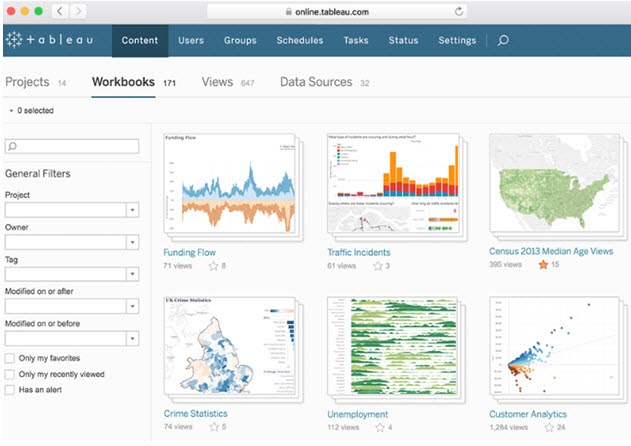
Tableau online can also be connected to live connections with many data sources like BigQuery, MySQL etc.
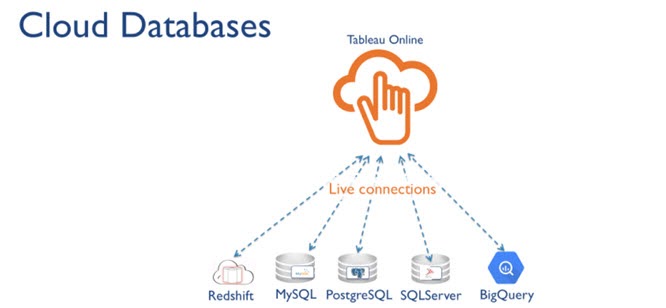
How is Tableau Server different from Tableau Desktop?
Below the points explain difference between Tableau Server and Desktop:
- Security
- Web Authoring Environment
- Performance
- Cost
- Scale Tableau to the enterprise means you can scale the Tableau Server as per your requirement (Scalability)
- Add self-service Capabilities
- Centrally Manage Collaboration
- Centralized Data Sources
- One more advantage of the tableau server is you can install the Tableau Desktop on your Tableau Server and publish your data.
Tableau Server Installation
- Double-click on the installation file.
- Follow the directions on your screen to complete the Setup Wizard.
- Install the application.
- After the installation, click on Next to open the Product Key Manager window
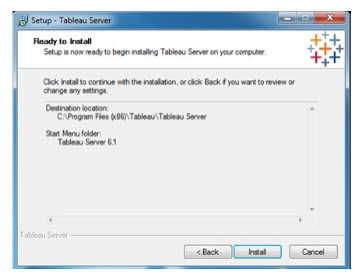
Activating the Product
After installing Tableau Desktop/Tableau Server, you need to activate your product. Both of them require product keys to activate these products.
Tableau Server requires at least one product key. It should be one that both activates the server and determines the number of license levels which can be assigned to users. Product keys can be accessed from the Tableau Customer Account Center.
Activate and Register
After installing and configuring the server, the product key manager opens up automatically so you can enter your product key and register the product.
- Select the Activate the Product
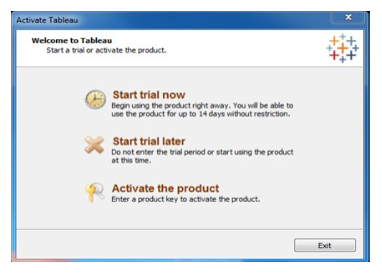
- Paste your server product key into the corresponding text box and click on Activate.
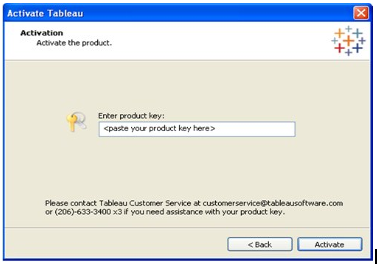
- When you are online, it gets over here. But when you’re offline, activation will fail and you are given the option to save a file that you can use for offline activation. Click on Save.
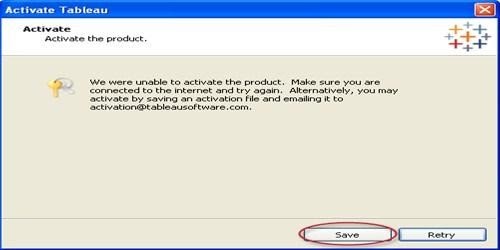
- Go ahead and select a location for the file and click on Save. The file will be saved as tlq and will contain information about the host the license is to be activated on.
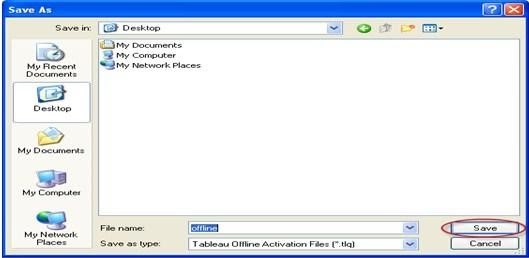
Configuring the Server
During a Tableau Server installation, the Tableau Server Configuration utility opens where you can set configuration options at this time, before the server starts.
The server starts at the end of the installation process.
- The Tableau Server runs by employing the Network Service account, by default.

2. Select whether you want to use Active Directory to authenticate users on the server.


Data Connection Configuration
The Data Connection tab is used to configure aspects of cache and initial-SQL-statement usage that applies to complete data connections.
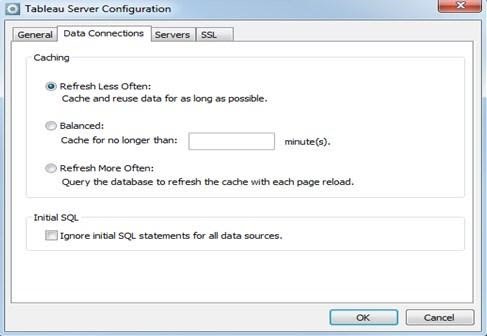
The views published to Tableau Server are very interactive and often have a live connection to a database. As users interact with the views in a web browser, the queried data gets stored in a cache. Subsequently, the visits will pull the data from this cache if feasible.
To configure caching
- Select the tab called Data Connections in the Tableau Server Configuration dialogue box.
- Then you can select from one of the following options;
- Refresh Less Often – Select this option when data is not changing frequently. Data is cached and reused whenever it is available regardless of the time of its addition to the cache. This option minimises the queries sent to the database and enhances the performance.
- Balanced – Data is removed from the cache after a specified time. If the data is added to the cache within the specified time range, the cached data will be used, otherwise, new data will be queried from the database.
- Refresh More Often – The database is queried each time the page is loaded. The data is still cached and will be reused until the page is reloaded by the user. This option will ensure users see the most updated data. However, it may decrease performance.
Setup Tasks
The following few steps are to add an administrator account.
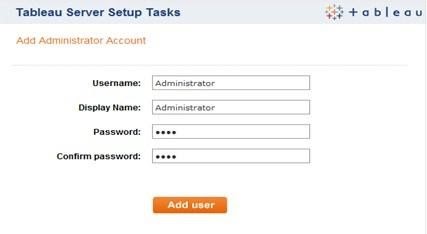
Setting Up Distributed Servers
After completing the initial configuration, set up the Tableau Server to run on multiple computers. This is also known as distributed installation or cluster. This increases the scalability of your Tableau Server environment.
- You can set the Tableau Server up to run on multiple machines. You can also fine tune which Tableau Server processes can run on individual machines (including the primary server).
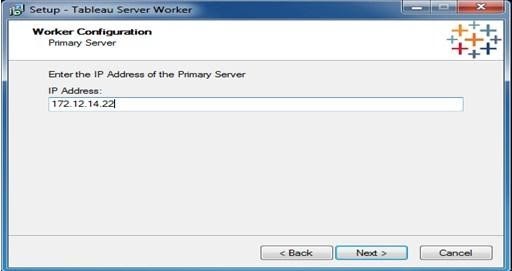
- This type of environment can help you support more users, improve viewer interaction and browsing. It also optimises the handling of server background tasks.
- Once the Worker software is installed on worker machines, you need to return to the primary server and open the configuration utility. You can do so by selecting Tableau Server 8 > Configure Tableau Server on the Start menu.
- In the Configuration Utility, go to the Servers tab and click on the Add button.
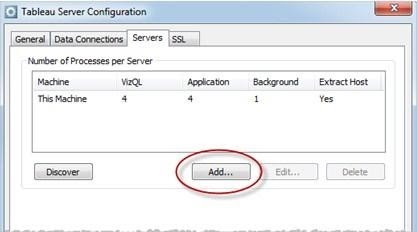
- In the dialogue box that appears next, type the IP Address for one of the worker machines. Indicate the number of VizQL Processes, Application Server Processes, and Background processes allocated to the machine.
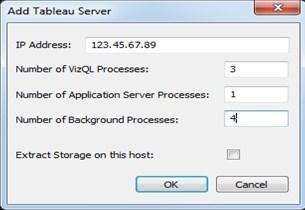
Adding Local Users
You can add all the individual users’ information and then import several users from a CSV file(Comma-Separated-Value file). You can also include attributes such as site role and the ability to publish,in the CSV file, in order to apply to the users at the same time to import them.
So, to add local users, you need to do the following;
- Log on to the Tableau Server by entering your admin username and password.
- Click on the option Users in the Administration area on the left side of the page
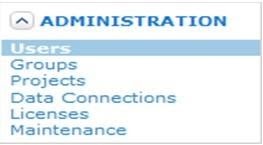
- Click one of the following links
- Add User to add users by specifying a username and password one at a time .
- Add Users From CSV File to add multiple users from a CSV file.
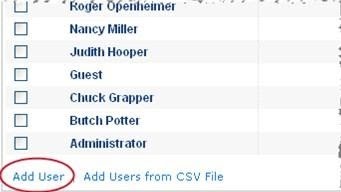
- Username – Type a username only consisting of letters and numbers.
- Full Name – Type a name for the display.
- Password – Enter a strong password.
- Confirm Password – Retype the password you’ve entered before to confirm it.
- License Level – Select license level.
- Assign User Rights – Choose whether it’s within the user’s authority to publish workbooks and assign administrator rights.
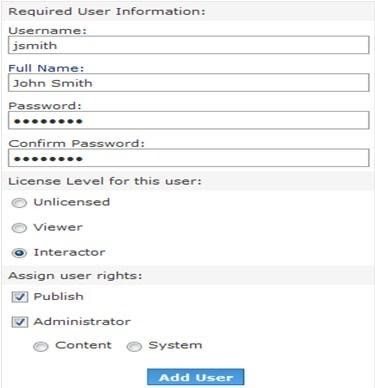
Conclusion
On ending up this tutorial, we have gone through the Basics of Tableau Server, Architecture and Components of Tableau Server, Installation, and Configuration process.
